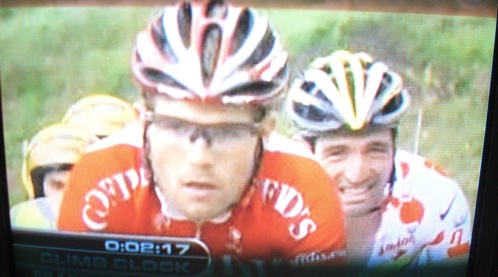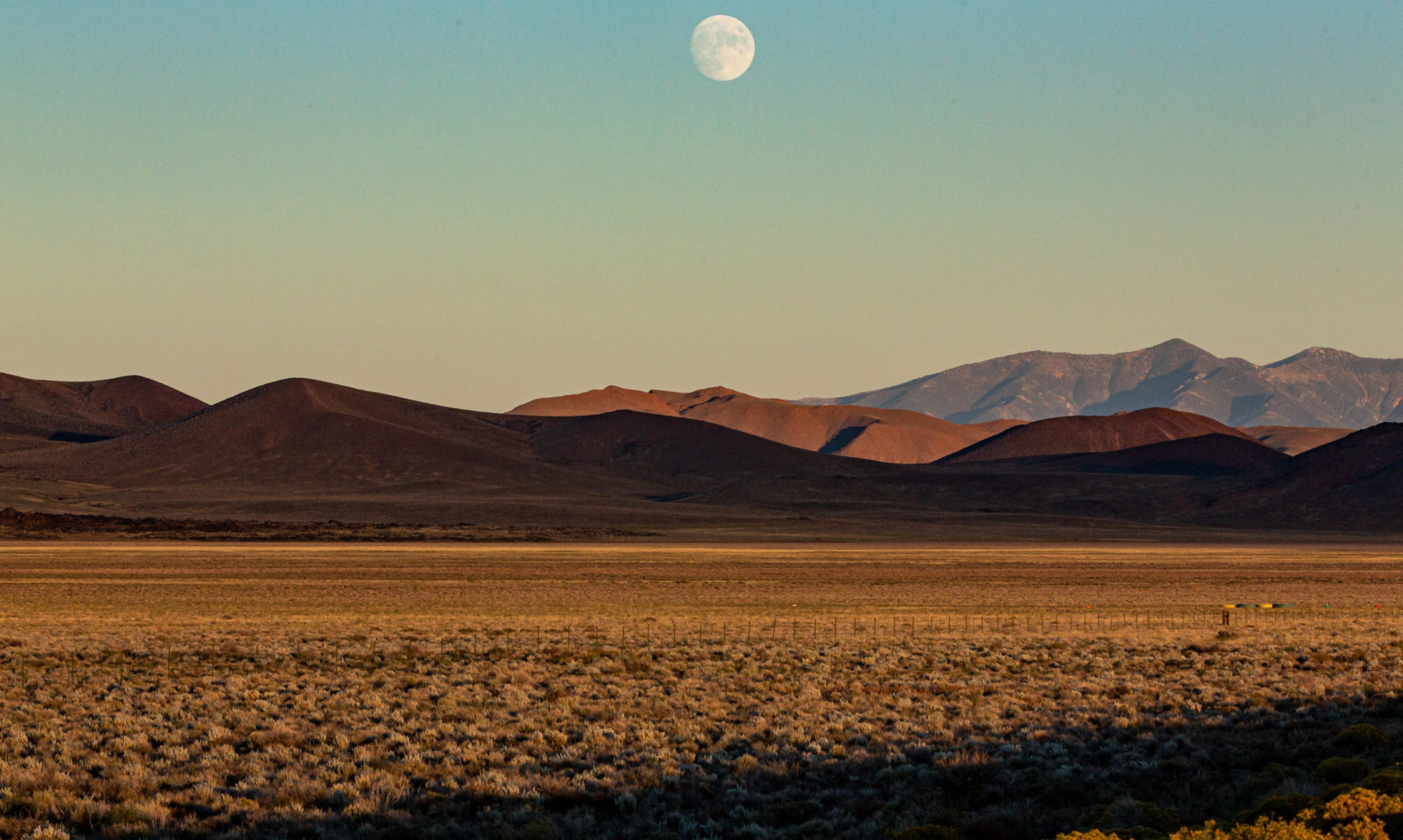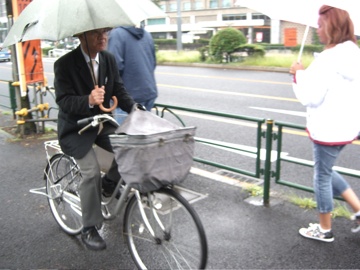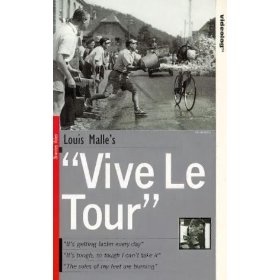On rare occasions, I’ll see a cyclist in Berkeley try this: riding a bike while holding an umbrella. I saw dozens of people doing so with seeming ease today. This guy was negotiating his way past a tour group on a sidewalk outside the Imperial Palace. Elsewhere, I saw a woman whose bike appeared to be fitted with an umbrella holder–a unit that also incorporated a headlight.
Bad Fish and Pedaling Machines
[Reposting from my other blog]
A must-see for the TdF fanatic, or even the mildly curious onlooker: “Vive le Tour,” an 18-minute documentary gem by the late French filmmaker Louis Malle. The film (available from Netflix and Amazon, among other purveyors), is a real time capsule, especially for viewers (like re:Cycling) whose Tour exposure dates back only to the 1980s.
The film depicts moments from the 1962 Tour (won, eventually, by Jacques Anquetil). There’s not much of a narrative thread–it’s an impressionistic look at the race, the racers, and the spectators. The riders’ appearance is striking: they seem old, haggard, and rather beat-up looking compared to the riders we’re used to seeing. In fact, one is reminded of pictures of baseball players in the major leagues’ alleged golden ages: these guys look like working stiffs who are riding as much to make a living as for the competition or some higher “sporting” values.
The shots of the route, the fans, the preceding caravan, the motorcycle corps that accompanies the peloton, the mountain roads–it’s all familiar stuff, but also quite foreign. You see an older, unpolished France here. The alpine routes look primitive. As wild as the crowds get today, there was even less of an imaginary barrier between them and the competitors: fans are depicted giving racers long, long pushes up the climbs. On the flatlands, the riders are shown stopping for impromptu water breaks and “cafe raids”–the latter involving physically running into cafes and carrying away bottles of water, soft drinks or even beer and champagne. We see a velodrome finish, and a slow, tortuous mountain descent.
The physical difficulty of the race and the toll on the participants is also highlighted. One rider–from his number, it appears to be Italy’s Giuseppe Zorzi–is depicted getting back on his bike after passing out and resuming his race. But not for long: he soon slows and topples to the pavement, hors de combat. (Tour references say he quit in stage six.)
But there’s one brief segment that offers a striking parallel to the age of Landis, Rasmussen and Vinokourov. There’s a scene of a very shaky looking rider–Hans Junkermann of Germany, though he’s not named in the film–climbing off his bike and settling disconsolately in a roadside ditch. The voiceover–not sure whose voice–says:
Now let’s talk about doping. In cycling slang, doping is called “the charge,” and “the charge is killing this profession. Now every time someone quits, he’s under suspicion. This racer told us he must have eaten some bad fish. That same day, ten racers quit, and each said he’d eaten bad fish. Contrary to popular belief, doping doesn’t give you extra strength. It simply suppresses the pain. The doped-up athlete no longer knows his limits. He’s nothing more than a pedaling machine.”
Bad fish. That’s one excuse we haven’t heard recently. (But here’s a little more on the “bad fish” affair of 1962.)
Technorati Tags: cycling, floyd landis, tour de france
‘The Best Way to See a City’
A marvelous little story in The New York Times: Reporter
Katie Thomas took a ride on regular old civilian bikes with
Olympians Jason McCartney (U.S.) and Michael Barry (Canada). She
wrote that McCartney seemed a little skeptical, but all that
changed once they were riding:
“… As we coasted along streets that were as flat as a moo shu pancake, McCartney was almost giddy. ‘Isn’t this the best way to see a city?’ he shouted.
“And it was. Heavy rains a day earlier had cleared Beijing of
the humid air we all had been living with for the past week.
The weather had been so oppressive that McCartney was one of more
than 50 riders who did not finish the road race.
“We breezed through Beijing in fast forward, pedaling past
storefronts decorated with Chinese flags, a mother washing her
toddler’s face, a pair of soldiers standing at attention. A block
or two later, the traffic cleared and the stone walls of the
Forbidden City appeared. Through an archway, we saw a cobbled
courtyard, stately trees, and hordes of Chinese tourists.
“ ‘You want to go in?’ McCartney asked. Although he had arrived in Beijing a week before, this was the first sightseeing he had managed to do, given his demanding training schedule. While the road race had taken McCartney past many of the city’s main attractions, they appeared as a blur. And because he is planning to compete in the Tour of Spain beginning Aug. 30, McCartney was leaving Beijing the next day.
We rested our bikes on their kickstands and had a look around. Within minutes, we had become our own attraction. First there was the man who wanted to sell McCartney a Mao watch. The leader’s hand bobbed up and down, ticking off the seconds. The man wanted 150 yuan, or about $22. McCartney smiled. ‘Twenty,’ he said, offering less than $3.
Then there was a teenage boy, who could sense that these two tanned, fit men clearly had something to do with the Olympics. ‘Did they win a medal?’ the boy asked. When he heard the answer was no, he walked away.”
[Belatedly: the story comes with a very cool two-minute audio
slideshow. Some great pictures of working bikes on the streets of
Beijing. Really well done on the part of the Times.]
‘The Best Way to See a City’
A marvelous little story in The New York Times: Reporter Katie Thomas took a ride on regular old civilian bikes with Olympicans Jason McCartney (U.S.) and Michael Barry (Canada). She wrote that McCartney seemed a little skeptical, but all that changed once they were riding:
“… As we coasted along streets that were as flat as a moo shu
pancake, McCartney was almost giddy. ‘Isn’t this the best way to see a
city?’ he shouted.
“And it was. Heavy rains a day earlier had
cleared Beijing of the humid air we all had been living with for the
past week. The weather had been so oppressive that McCartney was one of
more than 50 riders who did not finish the road race.
“We breezed
through Beijing in fast forward, pedaling past storefronts decorated
with Chinese flags, a mother washing her toddler’s face, a pair of
soldiers standing at attention. A block or two later, the traffic
cleared and the stone walls of the Forbidden City appeared. Through an
archway, we saw a cobbled courtyard, stately trees, and hordes of
Chinese tourists.”
[Belatedly: the story comes with a very cool two-minute audio slideshow. Some great pictures of working bikes on the streets of Beijing. Really well done on the part of the Times.]
‘The Best Way to See a City’
A marvelous little story in The New York Times: Reporter Katie Thomas took a ride on regular old civilian bikes with Olympicans Jason McCartney (U.S.) and Michael Barry (Canada). She wrote that McCartney seemed a little skeptical, but all that changed once they were riding:
“… As we coasted along streets that were as flat as a moo shu
pancake, McCartney was almost giddy. ‘Isn’t this the best way to see a
city?’ he shouted.
“And it was. Heavy rains a day earlier had
cleared Beijing of the humid air we all had been living with for the
past week. The weather had been so oppressive that McCartney was one of
more than 50 riders who did not finish the road race.
“We breezed
through Beijing in fast forward, pedaling past storefronts decorated
with Chinese flags, a mother washing her toddler’s face, a pair of
soldiers standing at attention. A block or two later, the traffic
cleared and the stone walls of the Forbidden City appeared. Through an
archway, we saw a cobbled courtyard, stately trees, and hordes of
Chinese tourists.”
[Belatedly: the story comes with a very cool two-minute audio slideshow. Some great pictures of working bikes on the streets of Beijing. Really well done on the part of the Times.]
Two Takes on the Climb

A sort of cheesy Versus screen grab from Tour de France Stage 9, the first Pyrenees day, on July 13. In the foreground: Maxime Monfort of Cofidis. He never showed any expression as he attacked on a tough climb. Behind him: David de la Fuente of Saunier-Duval, who briefly held the polka-dot jersey of the Tour’s leading climber. De la Fuente wore the same dramatic grimace all the way up the hill.
(De la Fuente eventually lost the jersey to teammate Riccardo Ricco, who in turn was ejected from the race after a reported positive test for a form of EPO; which ejection, in turn, caused Saunier, with de la Fuente, to quit the race.)
Technorati Tags: tour de france
The New Blog
As I said to an important advisor earlier today: Just what I need as a further diversion from the serious business of life–a new blog. It’s called re: Cycling, and I’ve been noodling around with it for awhile. Not that you can tell, necessarily: to the untrained eye, it resembles a blog just like the one devoted to your aunt’s pet cat’s colon surgery. What prompts the “announcement”–sure to propel waves of consternation across the far-flung Infospigot empire–is the onset of the 2008 Tour de France. For the most part, I’m going to make my Tour posts at re: Cycling. The extra special Tour posts with the added, deep existential dimension: those will appear here, too–if there are any.
The new thing is a work in progress. I have it in mind to ask a couple of riding and writing friends to become co-editors, contributors, and maybe do a couple little spin-off projects based on what we put together there. That’s a longer term project, though.
Any thoughts, suggestions, encouragement or condemnation: please send it my way.
Technorati Tags: blogs, tour de france
Greg Lemond on the New Tour
Versus, the jock cable TV network that promotes its Tour de France coverage as part of its “Red, White, Black and Blue Summer” (the network also presents bull riding and some form of fighting in which heavily muscled males punch and kick the crap out of each other), has another mission. With the consensus view now apparently settling on the belief that professional cycling before now was unspeakably shabby and riddled with drug cheaters, Versus is bending over backward to emphasize cycling’s New Really Clean Era.
OK, great. The Tour blew itself apart the last two years by stripping the 2006 champion, Floyd Landis, of his title, and then seeing its 2007 champion in the making, Michael Rasmussen, fired by his team a few days before the end of the race. Unspeakably dirty or not, the Tour was reduced to a shambles and came to represent not only the greatest feats in athletics but the worst of the doping believed to afflict cycling and elite sports in general. However, it’s more than a little disingenuous for Versus, which made built a good audience and raked in good money promoting the legend of Lance Armstrong, to turn around and strike the pose that those days were the bad old days.
As part of its New Clean Era coverage, Versus produced Greg Lemond for an interview on Sunday. Lemond, a great champion in his own right who has made a second career out of trying to undermine Armstrong’s accomplishments, is a spokesman for the Righteous Really Clean New Cycling. Lemond was odd in the interview, a little disjointed and tongue-tied and inarticulate. One of the Versus personalities, Bob Roll, tried to set him up with a question on the new age in the sport: “You have a huge legacy in this race. How do you see the evolution of the sport as it is right now?”
Lemond’s answer:
“I’m more excited about the cycling than I have been in years, and I think there’s a big change, there’s good people in it. Bob Stapleton and Jonathan Vaughters [the men behind the newly sponsored Garmin-Chipotle and Columbia teams] are really making a big effort. I think there’s a desire I’ve never seen before. It’s good. I’m positive.”
Translation: Now that Armstrong and the disgraced Landis have departed the scene, Lemond can get into the sport again. And there are classy people involved, not the scumbags who helped Armstrong eclipse Lemond as America’s greatest racer.
Roll’s cohost, Craig Hummer, asked an interminable question about the meaning of two big name U.S.companies signing on as team sponsors in the last month or so. Lemond seemed to come unhooked from any thread the interview might have had.
“Yeah — you know — cycling is — I’m actually very bullish on just the sport in general. When you look about — look at congestion, you look at the diabetes problem in America, um, it’s probably the best sport to do in terms of low impact but high cardiovascular output. And so I’m really bullish on the sport in general as a leisure activity in America. It is a sport of people past 40, but we need to get those kids in high school, and I’m very optimistic, and the Tour de France, you can’t duplicate this, this is magic, and, uh, I saw it last year, and, I mean, when Rasmussen and Vinokourov, it was quite depressing to my sons, but they still watch cycling, they watched the Tour of Flanders this year. It’s a great sport.”
(Congestion? My co-watcher theorizes he meant asthma.)
Technorati Tags: cycling, floyd landis, greg lemond, lance armstrong, tour de france, versus, vinokourov
Phil’s Liggett’s Quote of the Day
From the Versus Stage 1 telecast of the Tour de France:
“The beautiful scenery of Britanny now, remember we’re in Britanny now for three days, that’s what they’ve paid for and that’s what we’re gonna get and enjoy here on the Tour de France because these narrow roads constantly twist and turn, the undulations are very, very special here for all of the riders and 43 of them in their first Tour de France.”
Technorati Tags: phil liggett, tour de france, versus
The Tour 2008
With an exception of one day, our TV service has been off for about eight months. The one day we broke down and turned it back on was Super Bowl Sunday, and that just served as confirmation that 200 channels or whatever it is of satellite television wasn’t anything we were missing. For the most part, anyway. I will admit that it’s a little weird to hear people talking about Colbert or “The Daily Show” and think, wow, we just don’t look at that anymore.
And the other thing I’ve realized is that, the vulgar excess of the Super Bowl aside, TV is very much the way I keep up with the sports I still follow. So: no baseball this year and very little sense of how the season is unfolding beyond sporadic reports that the Cubs are doing well and that that poor, poor pitiful team in Tampa Bay is really having a year.
Tonight, though, we are linked up again to the broadcast world. The reason is the Tour de France, broadcast again on Versus. The first stage was today, and we got reconnected just in time to see the tail end of the first rebroadcast of the day. A Spaniard named Alejandro Valverde won in an oddly configured finishing section–a sharp descent followed by a short sharp climb that kept the usual contingent of crazy sprinters out of the picture. Valverde took the stage with a shocking burst of uphill acceleration in the last 250 meters that blew away a rider who looked like he had the stage in the bag. And besides the wonderful action, I knew the Tour was back when I heard Phil Liggett, back for the umpteenth year of melodrama, mispronouncing the winner’s first name. At various times it seemed to come out not only as Alejandro, but also as Alefandro, Alessandro, and, most weirdly and regularly, Alethandro. Phil, I missed you. MIthed you, I mean.
Tomorrow’s stage broadcast starts at 5:30 a.m. here, and we’re having our traditional “first Sunday of the Tour” gathering with some neighbors.
Technorati Tags: phil liggett, tour de france, versus


